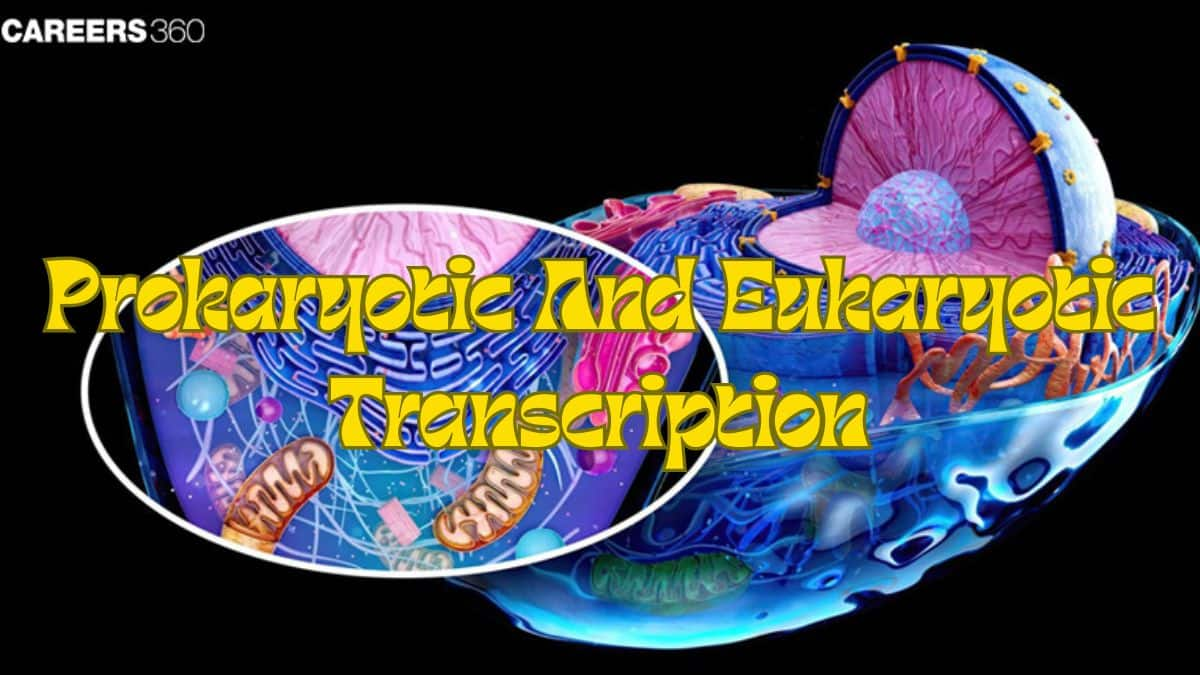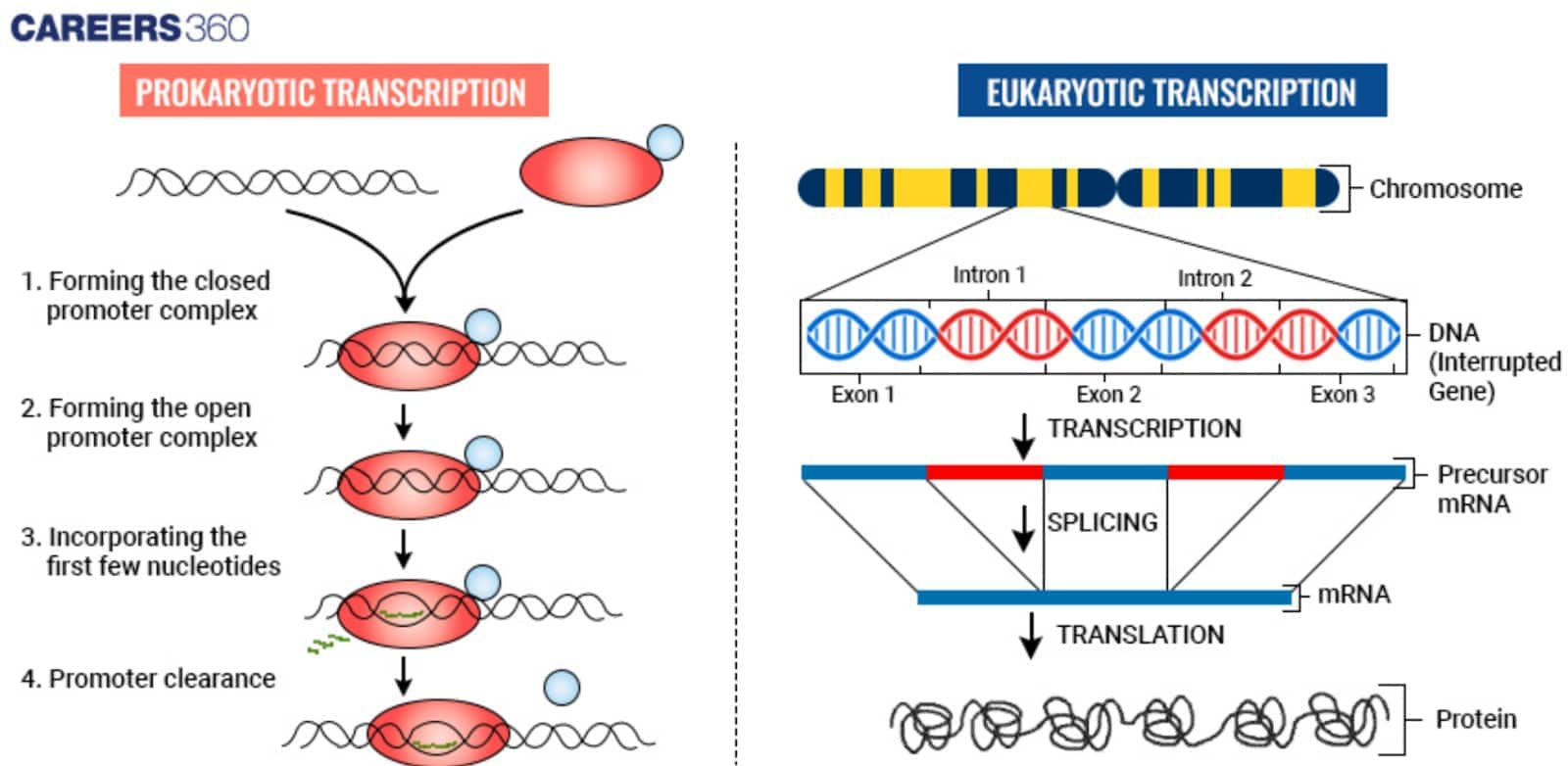Difference Between Prokaryotic And Eukaryotic Transcription
Transcription in prokaryotes and eukaryotes is the process of making RNA from DNA. Though the basic process is the same, the transcription process is different in both cell types. Prokaryotic transcription is simple and quick, while eukaryotic transcription is more complex and controlled. The difference between the prokaryotic and eukaryotic transcription processes is mainly in location, enzymes, and steps involved.
This Story also Contains
- What Is Transcription?
- Structural Differences Between Prokaryotes and Eukaryotes in Transcription
- Central Dogma Of Molecular Biology
- Major Differences Between Prokaryotic And Eukaryotic Transcription
- MCQs on Transcription

Prokaryotic transcription is simple and happens in the cytoplasm. Eukaryotic transcription is complex and takes place in the nucleus, with more steps, like RNA processing. These differences in the transcription process ensure that gene expression is well managed in each type of cell. The molecular basis of inheritance is seen in transcription, where DNA makes RNA.
What Is Transcription?
The process of transcription is among the most fundamental biological processes that involve the copying of DNA sequences of genes into RNA. The process of gene expression is preliminary to any other function executed by a cell. Transcription is the procedure for synthesising a complementary RNA molecule by reading the DNA strand through the enzyme RNA polymerase.
The difference between prokaryotic and eukaryotic transcriptions is one of the major and main areas of study by biologists. It shows how complex and evolved the mechanisms of a cell could be. For example, mechanisms of bacterial transcription serve as targets for antibiotic development, whereas eukaryotic transcription can provide valuable clues to the study of cancer and gene therapy. of inheritance is seen in transcription, where DNA makes RNA.
Structural Differences Between Prokaryotes and Eukaryotes in Transcription
Prokaryotes are simple, single-celled organisms without a nucleus. Bacteria are common examples of prokaryotes. Their transcription process is simple and happens in the cytoplasm. In contrast, eukaryotes have a nucleus and are more complex. Plants, animals, and kingdom fungi are eukaryotes. Their transcription process is complex, with many steps and RNA processing.
Prokaryotic cells are much simpler structurally. They have no membrane-bound organelles and possess only a single circular chromosome attached within the nucleoid region of the cell. On the other hand, eukaryotes have their linear chromosomes maintained in the nucleus, along with different kinds of membrane-bound organelles. These structural differences affect how transcription works in both cell types.
Central Dogma Of Molecular Biology
The central dogma of molecular biology shows how DNA makes RNA and then proteins. Both prokaryotic and eukaryotic transcription follow this step. But the transcription process is simple in prokaryotes and complex in eukaryotes. This difference helps each cell type complete the molecular basis of inheritance.
First, DNA is transcribed into RNA. Then, RNA is translated into proteins. Transcription makes RNA from a DNA template. This RNA can be rRNA, tRNA, or mRNA. mRNA carries the message to make proteins.
Major Differences Between Prokaryotic And Eukaryotic Transcription
The major differences between prokaryotic and eukaryotic transcription are based on cell structure and process steps. In prokaryotes, transcription is simple and quick. In eukaryotes, transcription is complex and occurs in the nucleus. These differences affect how genes are expressed in each cell type.
Feature | Prokaryotic Transcription | Eukaryotic Transcription |
Location of Transcription | ||
RNA Polymerases | Single RNA polymerase | Multiple RNA polymerases (I, II, III) |
Promoter Recognition | Sigma factors | Transcription factors and TATA box |
Initiation Complex | Simple (RNA polymerase and sigma factor) | Complex (RNA polymerase II, general transcription factors) |
mRNA Processing | Minimal to none | Extensive (capping, splicing, polyadenylation) |
Regulation of Transcription | Operons | Enhancers, silencers, and complex regulatory elements |
Transcription-Translation Coupling | Simultaneous in the cytoplasm | Separate (transcription in nucleus, translation in cytoplasm) |
RNA Stability | Short-lived mRNA | More stable mRNA (due to processing and protective features) |
Post-Transcriptional Modifications | Rare | Common (alternative splicing, RNA editing) |
Chromatin Structure | Not present (naked DNA) | Present (DNA wrapped around histones forming nucleosomes) |
Introns and Exons | Usually absent (continuous coding sequences) | Present (genes split into exons and introns) |
Response to Environmental Changes | Rapid and direct | Slower and more regulated response |
Diagram: Prokaryotic And Eukaryotic Transcription

MCQs on Transcription
Question: The transcription of DNA to a molecule of messenger RNA occurs:
On the ribosomes
In the cytosol
In the nucleus
only during cell division
Answer: The RNA polymerase enzyme is essential to the production of mRNA during transcription because it moves through the DNA strand and puts the matching ribonucleotides together. An essential bridge in the transfer of genetic information from DNA to protein synthesis is created as a result, producing a complementary mRNA strand.
Option (A) is incorrect because the ribosome is the site of protein synthesis in the cell.
Option (B) is incorrect.
Option (D) is incorrect
Hence, the correct option is 3) In the nucleus
Question: The enzyme that performs transcription is ____________.
DNA polymerase
DNA ligase
RNA polymerase
Reverse transcriptase
Answer: 1) DNA polymerase that catalyzes DNA replication
2) DNA ligases catalyze the formation of phosphodiester bonds at single-strand breaks in double-stranded DNA.
3) DNA-dependent RNA polymerase catalyzes transcription on one strand of the DNA
4) Reverse transcriptase catalyzes the RNA-dependent polymerization of DNA and is responsible for maintaining genetic information in the more stable form of DNA.
Hence, the correct answer is option 3) RNA polymerase.
Question: Which of the following is a key difference between prokaryotic and eukaryotic transcription units?
Prokaryotic transcription units contain both introns and exons, while eukaryotic transcription units contain only exons.
Prokaryotic transcription units do not contain a promoter region, while eukaryotic transcription units do.
Eukaryotic transcription units are transcribed by RNA polymerase II, while prokaryotic transcription units are transcribed by RNA polymerase I.
Prokaryotic transcription units contain multiple genes, while eukaryotic transcription units contain only one gene.
Answer: Prokaryotic transcription units contain multiple genes, while eukaryotic transcription units contain only one gene. Prokaryotic transcription units typically contain multiple genes arranged in an operon, which is a single transcription unit that produces multiple mRNAs. In contrast, eukaryotic transcription units generally contain a single gene that is transcribed into a single mRNA molecule.
Incorrect option 1. Prokaryotic transcription units contain both introns and exons, while eukaryotic transcription units contain only exons.
This option is incorrect. Prokaryotic transcription units do not contain introns and exons, as these structures are unique to eukaryotic genes. Prokaryotic genes are typically organized into operons, which are clusters of functionally related genes transcribed as a single mRNA molecule.
Incorrect option 2. Prokaryotic transcription units do not contain a promoter region, while eukaryotic transcription units do. This option is incorrect. Both prokaryotic and eukaryotic transcription units contain a promoter region, which is necessary for the initiation of transcription. The promoter region is the DNA sequence that RNA polymerase recognizes and binds to to initiate transcription.
Incorrect option 3. Eukaryotic transcription units are transcribed by RNA polymerase II, while prokaryotic transcription units are transcribed by RNA polymerase I. This option is partially correct. Eukaryotic transcription units are transcribed by RNA polymerase II, which is responsible for transcribing protein-coding genes. However, prokaryotic transcription units are transcribed by RNA polymerase holoenzyme, which consists of RNA polymerase core enzymes and other factors.
Hence, the correct answer is option 4) Prokaryotic transcription units contain multiple genes, while eukaryotic transcription units contain only one gene.
Also Read:
Frequently Asked Questions (FAQs)
One of the features that distinguish eukaryotes from prokaryote-like Archaea is the possession of multiple RNA polymerases (I, II, III) that specialise in the transcription of different RNA types. For instance, in eukaryotes, it is RNA polymerase I that transcribes the rRNA, while RNA polymerase II synthesises mRNA. Lastly, RNA polymerase III synthesises tRNA and other small RNAs. For this reason, more fine and controlled gene expression is possible.
Usually, in prokaryotes, mRNA is directly transcribed and translated with no noticeable modification. In eukaryotes, mRNA undergoes intensive processing, normally the inclusion of 5' capping, splicing to remove the introns, and 3' polyadenylation. It is requisite for mRNA stability and the efficiency of translation.
Transcription factors are proteins involved in the initiation and regulation of eukaryotic transcription. They bind to specific DNA sequences, probably recruiting RNA polymerase II and other essential components to form the transcription initiation complex that goes on to control gene expression.